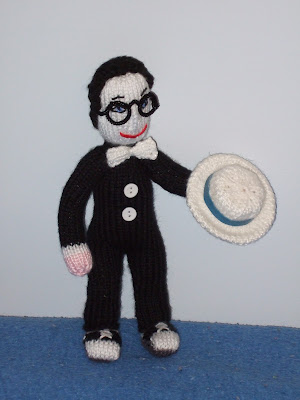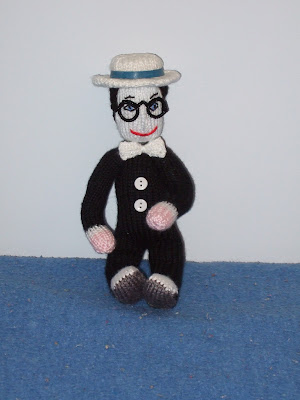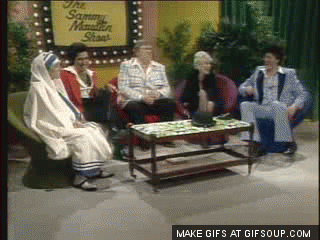Since my enthusiasm so often runs ahead of my knowledge, I'm writing this in advance of knowing anything about my subject. Or not much. I have ordered a biography from Amazon called Oscar Levant: A Talent for Genius, one of those 500-page doorstops I love so much, but for this post I'm pretty much winging it.
He was a strange one, and I have strange feelings for him, attraction and repulsion at the same time. Who wouldn't love a man who could play the piano like that? NOBODY could play the piano like that, poetic sensitivity melded with a gangster's rat-a-tat-tat aggressiveness.
Nobody looked like him either, with that sensual, almost Polynesian mouth, the flop of hair that whipped around as he played, the constant manic bobbing and weaving (particularly later in life when he was in the throes of God-knows-what sort of addiction/affliction) reminding me of Michael J. Fox. The grief-stricken, fathoms-deep eyes, the forlorn eyes of an abandoned child, that could quickly flip over into fierceness, to a sense of "yeah, make me", or even blanked-out indifference.
Oscar Levant was an updated Oscar Wilde without the effeminacy. You knew he wasn't gay by the way he eyed women. Only his personal charm saved it from being a leer. Some glamorous dame would kiss him on the cheek (he played the harmless, charming, eccentric sidekick in all his movies) and he'd lunge at her neck. He got away with lines that would have been censored without that lightning-stroke, oddly monotone delivery: "It's a good thing Marilyn Monroe has gone kosher, because now Arthur Miller can eat her."
Seductive, but somehow - offputting - as he evolved into a sort of comic hired gun, an outrageous joke-machine that spewed them out on demand. The narrow-eyed, double-breasted gangster demeanour, cigarette constantly dangling from those Filipino lips, deteriorated most awfully over the years as mental illness slowly consumed him. He ended up, no kidding, a real bona fide mental patient, institutionalized, getting shock treatments right during movie shoots so that he had to have himself signed in and out for his scenes (at one point actually playing a mental patient, a part he described as "Pirandelloish").
That's sad. That's sadder, even, than the elderly Dorothy Parker and her poodle called Cliche holed up in her fusty ash-and-bottle-strewn apartment, watching soap operas all day as her friends edged away from her one by one.
Oscar Levant had friends aplenty, but did they keep him around just because he was so entertaining? Did he sit down and think about all those viper-strike lines, actually write them down, or did they just pop out of him like Athena from the head of Zeus? He had an extremely loyal wife who became a caretaker in later life, and three pretty, vivacious daughters. He had a lively, varied career that most people would envy, considerable fame and adoration, and at the same time the most awful, soul-destroying depression that finally claimed him and sucked him under. It's hard for me to even think about it.
People sometimes called him a sellout; he did coattail on his close association with George Gershwin, who did Levant a big favour by croaking at age 38. Levant was automatically assumed to be his successor, but who can follow George Gershwin? Not even George Gershwin. Oscar Levant composed, but it doesn't hold together somehow. He's a sort of Schoenberg on ice, a "look-at-me-I'm-a-composer" performing triple axels at the keyboard. The music is technically good, but it doesn't say anything.
His classic, often-misquoted line was, "There is a fine line betwen genius and insanity. I have erased that line." He constantly joked about suicide and his own craziness, causing an uneasiness and even fear that, for some uknown reason, was viewed as hilariously funny. He was, I think, the first shock comedian.
So, that's what I know, and it ain't much because it's less than what's in the Wikipedia entry. I think his doorstop of a biography (which I will consume in installments propped up in bed before sleeping) will be a wild ride, or else it will be boring, as some biographies inexplicably are.
So I took the ones I could find, many of them extracted from old album covers, and because they are in the public domain, and because Oscar said I could, I tinkered with them. Something leaped out at me, a kind of predatory energy. There were so many dimensions to him. He looked different in every shot (and I've excluded some of the later, really painful ones). In a few of them he looked like a young Alan Arkin.
Out of those ancient grey lithographs emerged Shakespearian spectres, that is, if Shakespeare had dealt in slighty off-colour wisecracks. And many of the black-and-whites, particularly very dark concert shots, exploded into colour, which as far as I know is impossible (i.e. it's relatively easy to go from color to black and white, but how is it possible to go the other way?). But in every case, no matter how much I altered the original, he was still Oscar. His essence came through every one of the masks.
People were known to say things like, "Oh! That's Oscar Levant. You know, he could have been. . . " But if he had "been", as they say, we'd know nothing about him now. He would've had a stellar career as a concert pianist, then sunk out of sight, with only a few musty-smelling LP covers to remind us of who he was.
Instead we have quite a few "sidekick" movies where he's somehow irresistable in his craziness, and a few YouTube videos that are a little disturbing to watch, as he becomes a sort of tame circus tiger on pointless panel shows. He even does a turn on his own show, and the one surviving kinescope is excruciating: he slurs and bobs around like Ray Charles at the piano while his wife sits close beside him like a watchdog, making sure he doesn't fall over the edge.
And he did fall over the edge. What's on the other side of it? Nothing, or a reunion with his pal Gershwin, or celestial piano keys waiting to be played? Considering the chaos of his life, I think oblivion would have been more than enough.
CODA: I'm not sure I'll be writing about Levant again. In fact I kind of hope he won't be another Harold: making an Oscar doll would just be too challenging. But I did find out something about his death, so I'd better get to it now. Too bad he wasn't around to enjoy it, for he was morbid enough that I think he would have found the bizarre circumstances amusing.
Though everyone seems to think he was a complete wreck at the end, like everyone else with serious mental illness he also had his good days. Days when he could noodle around on the piano, talk to his wife June, take a nap. This is what happened: he went upstairs to lie down for a while (for, at age 65, he was already frail from years of drug abuse), to rest up for an interview he'd be having later in the day with a certain fresh-faced young photojournalist.
Her name was Candice Bergen.
Late in the afternoon when the doorbell rang, his wife welcomed Candy in, all bubbly and excited about meeting this living legend. June called upstairs:
"Oscar! She's here!"
No response.
"Going deaf, obviously. Oscar! Come on down now."
"Oh, it's OK, Mrs. Levant, if he wants to. . . "
"OSCAR." She looked at Candy in puzzlement. "What's he up to? I'll be right back."
Mrs. Levant went upstairs and into the bedroom. He was curled on his side in a fetal position, the way he always napped, the corner of a blanket childishly wrapped around his head.
"Oscar."
The silence was profound.
"Oscar." She touched his shoulder, then drew back with a gasp.
It must have been hard for Candice Bergen, being assigned a plum interview like that, an interview with pictures, to have to report back to her editor, "Uh, sorry, but I couldn't do it."
"Couldn't do it? Why not?"
"He's dead."
"Dead?"
"Dead."
"Oh. Are you - "
"Sure? Yes, I'm sure."
"Oh."
"He's sure, too."
Then they both disgraced themselves - and each other - by collapsing into helpless laughter.
I'm glad, though. Not glad he's dead - I'm not that mean - but glad that such a turbulent, often agonizing life ended in such sweet surrender. It was like the tide going out: his heart stopped; it was time to go home.






.jpg)
.jpg)














































